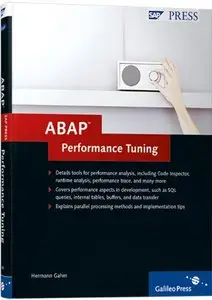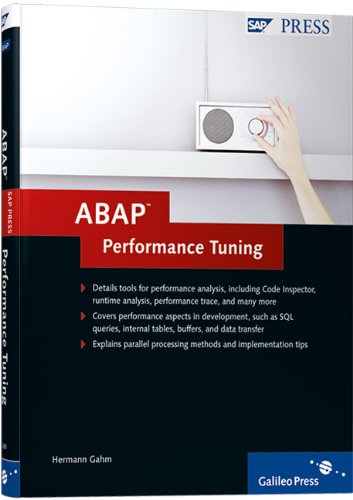ABAP Performance Tuning by Hermann Gahm
2009 | ISBN: 1592292895 | English | 348 pages | PDF + EPUB | 32 MB + 22 MB
2009 | ISBN: 1592292895 | English | 348 pages | PDF + EPUB | 32 MB + 22 MB
This book is your guide for analyzing and optimizing ABAP source code (ABAP/4 and ABAP Objects). You’ll learn about the analysis tools and performance-relevant technologies, and you’ll discover how you can analyze existing source code and enhance your programming style. This is the resource you need to ensure that your ABAP programs are fully optimized.
1. Analysis Tools After reading this book, you’ll know when and how to use analysis tools properly — including Code Inspector, performance trace, ABAP trace, or single records statistics.
2. Programming Technologies Get detailed information on parallel processing, internal tables, SQL data processing, and much more, and learn how these technologies affect performance.
3. Buffering Explore the different buffers that are available onthe SAP NetWeaver Application Server ABAP, and learn the most important buffer options to avoid unnecessary database accesses.
4. Database Tuning You’ll obtain a description of the database architecture and the technical background of database accesses, and master the tuning options for database accesses.
5. New Developments Learn from a comprehensive overview of the new developments in ABAP Release 7.0, EhP2, such as Transaction SAT, the innovations of the performance trace, and changes of internal tables.
Highlights:
Analysis Tools: Code and Memory Inspector, Selectivity and Process Analysis, Debugger, Performance Trace, ABAP Trace, E2E Trace, Single Records Statistics
Parallel Processing
Data Processing with SQL: Access Strategies, Resulting Set, Index Design, Execution Frequency, APIs
Buffering: Buffering Types, Sessions, Shared Objects, Table Buffering
Internal Tables: Table Types, Reading, Changing and Deleting Tables, Secondary Indexes, Nested Loops
RFC Communication



